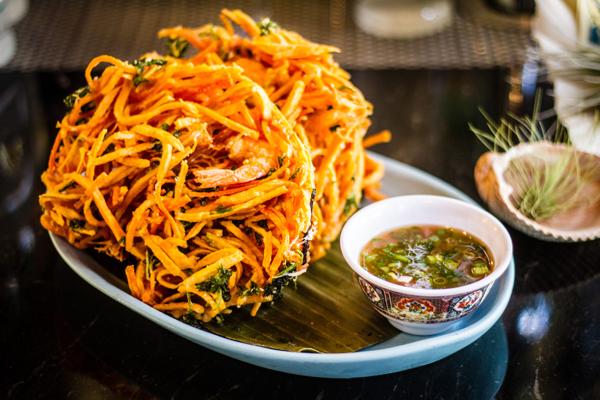Filipino restaurant Bad Saint in Columbia Heights is unashamedly true to its heritage. Crafting crisp, clean dishes, it earned a spot as the second-best restaurant in the U.S. this year by Bon Appetit magazine.
To win a coveted spot for dinner at the tiny, 24-seat restaurant, people start lining up as early as 3:30 p.m., with the line stretching down the block by the 5:30 p.m. opening time. Parties with more than four people can’t get a table at Bad Saint at all.
Guests at the start of the line are welcome to put their name on the waitlist for another time, but Bad Saint doesn’t take reservations or call-aheads.
My first attempt at trying to dine at the restaurant was a no-go, and Genevieve Villanova, one of the owners, advised me to come back the next day as early as possible.
The second time around, I got lucky and was seated by the kitchen, which was seamlessly integrated into the main dining room.
Despite the claustrophobically small space, Bad Saint’s decor was impeccable. The natural theme was echoed in the wood and bamboo that covered every surface, although the venue was a touch too casual to be described as minimalist or modern in any sense. Rather, the combination of dimmed lights and twisting, traditional patterns on the ceiling spoke of antiquity and culture.
Interspersed on the walls were images and motifs harkening back to Bad Saint’s Filipino roots – a painting of native, Catholic angels and even a hidden lucky cat.
The decor was a fitting preface to its food, since staying true to its roots is what Bad Saint is all about. After careful consideration and helpful advice from the server, I chose a Kinilaw salad ($12) and Maya Maya fried fish ($24), paired with a papaya lemongrass soda ($4).
If I had to describe the entire meal in one word, it would be tropical. And if I could add a second word, it would be fresh.
The Kinilaw was easily the most interesting dish I tried — at first, I couldn’t quite comprehend the complex flavors in the dish. My brain struggled to sort out the party of flavors that had exploded in my mouth, picking out hints of sweet and spicy, crunchy and smooth.
Somehow the shrimp blended into the flavors of mango and papaya, accented every now and then with a bite of beet, cucumber or fennel. A type of Philippine spice that tasted vaguely like shichimi perfectly offset the sweet and sour notes in the cold salad.
The snapper – known as Maya Maya in Filipino – was infinitely more simple to comprehend, although more intimidating in presentation. The fish had been fried, head and all, so the skin was crispy, but not oily, and the meat inside butter-soft. A sharp marinated cabbage salad cut through the otherwise fatty taste.
The server was stellar throughout the entire meal, prefacing every dish with a brief history and explanation on the ingredients before leaving me to dig in.
He also brought me banana leaf-wrapped sticky rice bar called a Suman, on the house. It served as an easy appetizer for the rest of the meal, with notes of coconut accenting the rice.
All the entrees on the list ranged from $10 to $30 — a little pricey but not unheard of for a student to spend in the District, especially for a special occasion.
All in all, it was clear why Bad Saint had been named the second-best restaurant in the nation. The one-year-old restaurant marries tradition to innovation, all the while creating a fantastic dining experience where the wait staff focuses on you as a true guest, rather than a paying customer.
Bad Saint makes dining a personal adventure into the jungles of the Philippines, challenging the diner to embrace complex flavors rather than babying them.
Two thumbs high in the air — although next time, I’ll bring a book to read in line.








